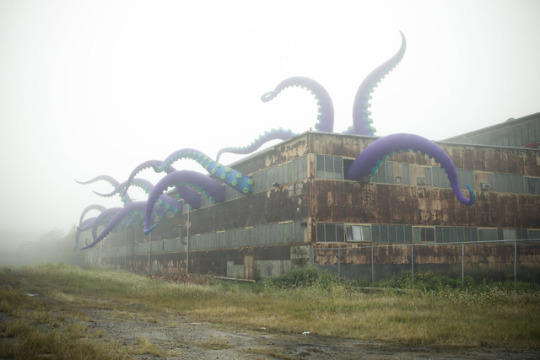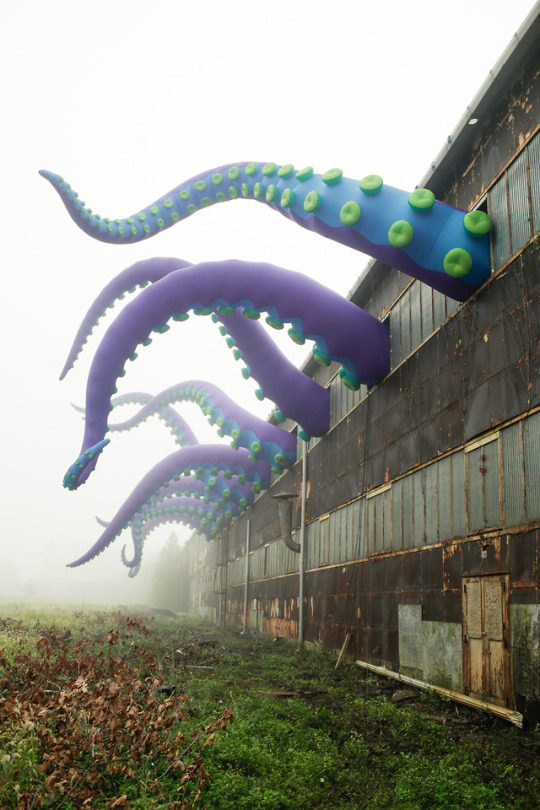Text
Studio Visit: Shay Arick
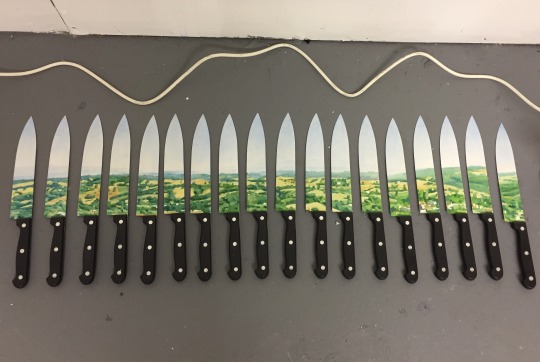
“Landscape might be seen more profitably as something like the ‘dreamwork’ of imperialism, unfolding its own movement in time and space from a central point of origin and folding back on itself to disclose both utopian fantasies of the perfected imperial prospect and fractured images of unresolved ambivalence and unsuppressed resistance.” - WJT Mitchell, Landscape and Power
[Chai, Shay Arick, Eighteen oil painted knives of an Israeli panorama based on a painting by the artist Israel Hirschberg]
0 notes
Text
Studio Visit: Glexis Novoa

“Ruin,” literally meaning “collapse,” is the subject of much of Cuban artist Glexis Novoa’s work. Through installation, performance and drawings, Novoa explores the aesthetics of vanishing cityscapes of power, ranging from emptied brutalist architecture to the toppling of once-grand Soviet iconography. In his public art installation El vacío (Emptiness), he places 15 tiny graphite drawings (most less than an inch tall) throughout the ruins of a Havana building — a hotel from the 1800s turned into an abandoned construction project during the Cuban Revolution.
The site is a ruin within a ruin, and through his intervention, Novoa adds one more layer of ruination by scattering representations of Cold War authoritarianism throughout the structure. An iconic statue of Lenin is reduced to a miniature, hiding in the corner of a decaying wall. What looks like an American-made bomber floats along a horizon line that Novoa draws across a column, connecting one side of the ocean with another.
If “ruins make us think of the past that could have been and the future that never took place,” as Svetlana Boym writes, then Novoa’s more recent work brings the past forcefully into the present, warning us of the very real potential of fascism to permeate our political and social systems. “Some may call me a pessimist,” he says, “but I’m more of a realist.”
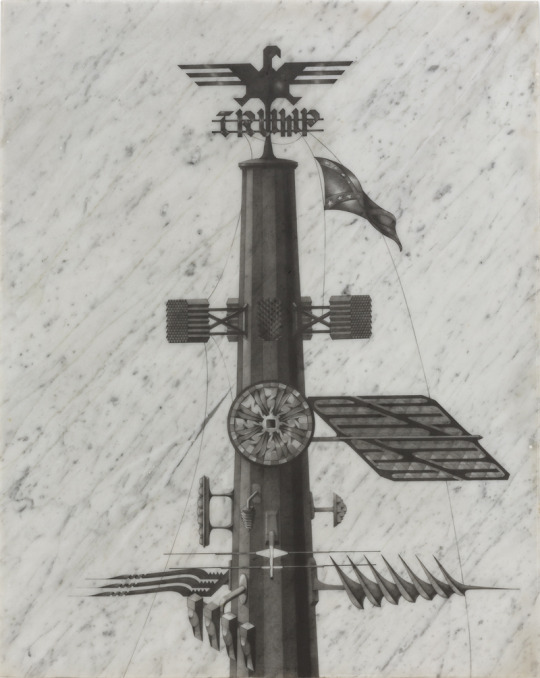
0 notes
Text
Studio Visit: Lee Tzu-Tung

In the aftermath of conflict, transitional justice mechanisms—including truth and reconciliation commissions, reparations, memorials, and tribunals—may be enacted as a form of social repair, to bring forward a sense of accountability, stability and justice and to prevent the repetition of past violations. What does transitional justice mean in an era of social media?
In #Ghostkeepers, Taiwanese artist and visual anthropologist Lee Tzu-Tung revives deceased victims of political violence through a series of Facebook accounts. She invites participants to bring to life these unknown “ghosts” on the Internet for just over a month. Among the avatars who show up online are Hsieh PY, a Taiwanese political prisoner; Carlos Torres, a Columbian trans man who was murdered in a 2015 hate crime; Tóth Ilona, a Hungarian doctor who was shot to death in 1956 for revolutionary activities; and Ivan Matic who starved to death during the 1995 Bosnian Genocide. The avatars post about the circumstances of their own death and the trauma of the violence they experienced. They find peace in visiting memorials, as when Tóth Ilona comments on her surprise at seeing a statue of herself, yet feels a sense of unease at being memorialized when many of her comrades deserve to be recognized as well. Ivan visits a cemetery near Srebrenica, and writes about what it means to finally hear the terms “war crimes” and “genocide” for the first time. All of the avatars interact with one another in the comments section, trading words of solidarity and support across time and place.
The project also contains a profile of a perpetrator, Rhino Black—a Guatemalan air force general who struggles with his own accountability in the Guatemalan genocide (1960-1996), in which Mayan civilians were massacred during the military government’s counterinsurgency operations. On his revived Facebook page, Rhino posts a photo of the trial of Guatemalan dictator Efraín Ríos Montt and asks: Am I a soldier or a murderer?
The avatars are brought together in a gallery space on computer screens which are buried in piles of soil. The set-up is reminiscent of Tania El Khoury’s Gardens Speak, in which visitors to the gallery must sift through mounds of dirt to find speakers containing the oral history testimonies of Syrian activists and protesters murdered for their role in the uprising against Bashar al-Assad. Tzu-Tung explains that after the closing of the #Ghostkeepers show, the Facebook posts are printed out and burned in a funeral service, their stories sent back to the spiritual world.

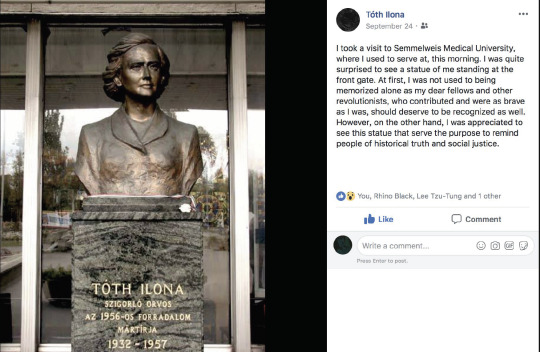
#transitional justice#genocide#post-conflict art#facebook art#social media art#avatar#taiwanese art#taiwan#guatemalan art#Lee Tzu-Tung
0 notes
Text
Studio Visit: Rashwan Abdelbaki
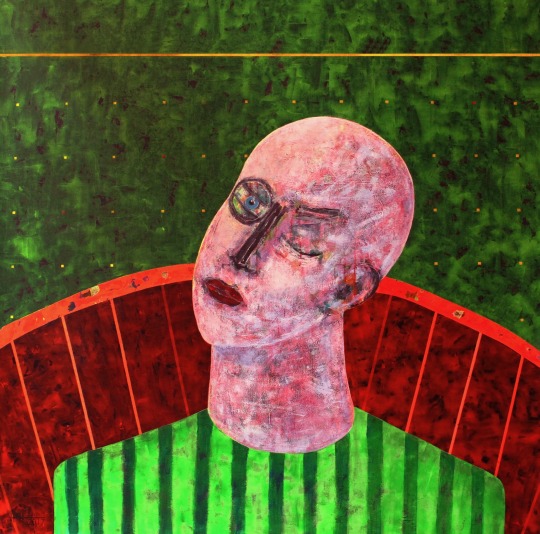
A character appears throughout the work of Syrian artist Rashwan Abdelbaki—a figure with one eye open and one eye closed. “He represents the fear inside all of us,” he explains. “We can’t sleep without one eye open. The madness in the world keeps us awake.” While the character emerged out of his experience as a Syrian artist from war-torn Syria, it speaks to a more universal distrust and fear that operates through racism, religion and politics. The figure is often painted wearing striped garments in empty cells. “These people, like all people, are prisoners of their own beliefs,” he says. “This is the condition of the world. The condition of humanity at present. But I also see light in that darkness, so I use colors that feel joyous to me. There is hope.”
0 notes
Text
Studio Visit: Nadežda Kirćanski

Nadežda Kirćanski’s installation nista spec 1.0 (nothing much 1.0), transforms a gallery space into the cold and alienating waiting room of a hospital ward. The anxiety of perpetual waiting is triggered by the smell of iodine, the sterile color of mint, and the circular arrangement of the chairs which face away from each other in a ring. On the walls are light projects of a pharmacy counter and perpetually closed doors which lead into hospital rooms.
The title of the piece is “nothing much,” the typical response to the question “what’s up?”—a response which is repeated as a meaningless mantra of youthful conversation, but always conceals a more complicated reality beneath it. Kirćanski hopes to uncover this reality, in which Serbia’s youth are increasingly trapped between unreal societal expectations generated by neoliberal individualism, and the failures of public safety nets that land them in perpetual waiting rooms.
She explains that during gallery tours, a number of visitors are always moved to tears. “Everyone has a waiting room experience,” she says, “there is a lot of trauma in this space.” While the installation might look like “nothing special” or “not much,” its cold aesthetic reveals an extreme vulnerability brought about by cracks in the system.
0 notes
Text
Studio Visit: Carl Martin Hansen
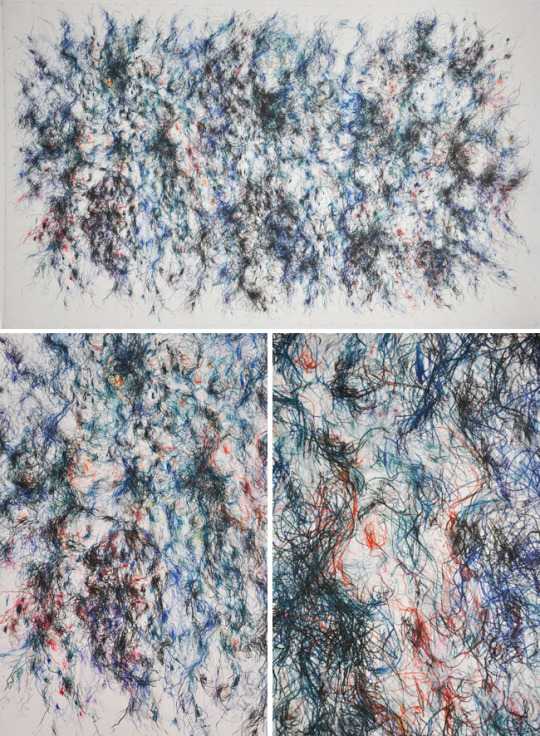
“It’s not about painting a specific scene,” says Norwegian artist Carl Martin Hansen, “it’s about what I’m evoking.” His sculptures, drawing, and paintings are rendered through intuition, their wild textures and passionate colors driven by his meditations in nature as well as the rock music he listens to while he works. Some of his drawings contain snippets of lyrics scrawled throughout the canvas, alongside other streams of consciousness. His latest project No Expectations brings together his exploration of landscape, musical impressions, and the psyche. Published as an artist book, the project captures his stay at Svalbard, a Norwegian archipelago near the North Pole, and includes pages of color palettes, photos and drawings.
“Being in Svalbard in February was a strong experience,” he explains. “I wish to communicate some of the physical experience of being there. It is both incredibly beautiful, but also [a] very tough and potentially dangerous – and vulnerable – landscape. The strong color surfaces of the book are reflections of my personal meeting with the landscape, the cold and the dramatic light changes, and a reflection of the rhythmic pulse of the music.”
The title of the project refers to the lyrics of a Rolling Stone song with the same name, and is a reminder that the glaciers that make up the landscape are slowly disappearing.
#carl martin hansen#nature#art#residency#residency unlimited#landscape art#climate art#arctic#north pole#music#rolling stones#norwegian art#meditation#meditative art#abstract art
0 notes
Text
Studio Visit: Emilie Régnier
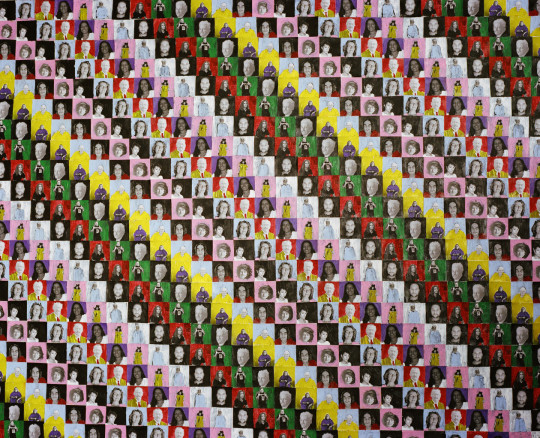
In her Passport West Africa series, Haitian-Canadian photographer Emilie Régnier lets her subjects fashion their own identities for passport-style photos. The result is a colorful array of portraits that illustrate the diverse identities of West African youth. Much like French filmmaker Jean Rouch’s method of shared anthropology, in which the process of filmmaking could directly provoke subjects to express their inner feeling, Régnier’s practice gives her subjects the space to perform before the camera, staging dramatic versions of themselves and imagining alternative ways of engaging with the world.
This playful performativity shines through another of her portrait series, in which she photographs subjects who wear leopard print: a variable symbol of power, wealth, eccentricity, sophistication and sometimes tackiness. For Régnier, the print also contains a transnational message, as it has traveled between the African continent and the West.
In her more recent work, she explores her own transnational identity, assembling patchworks of familial faces, all of whom share segments of DNA with her. “Paternal Bloodline” is a checkerboard featuring the artist, and her father, grandfather and great-grandfather. In “Us,” a photo of the artist as a young girl is printed alongside images of her parents. The project is reminiscent of Taryn Simon’s Living Man Declared Dead and Other Chapters I – XVIII, in which the photographer traveled around the world recording bloodlines and their related stories, mapping relationships among individuals connected by blood, history, and chance. Yet unlike Simon’s portraits, Régnier’s DNA quilts are warm, colorful and personal. As a person of mixed race, Régnier hopes to portray the collision of her world and consolidate two distinct universes. “I am white and black, I am Canadian and Haitian,” she explains. “This project is an attempt to unify my extremes, to finally exist between my father and mother, to reappropriate my own history by creating a family portrait of people I never knew, extending it beyond my immediate relatives.”
#emilie regnier#residency#art residency#residency unlimited#haitian#canadian#haitian art#family tree#bloodline#passport photos#west africa#leopard#jean rouch#taryn simon#photography#transnationalism#transnational art
0 notes
Text
Studio Visit: Max Ruf
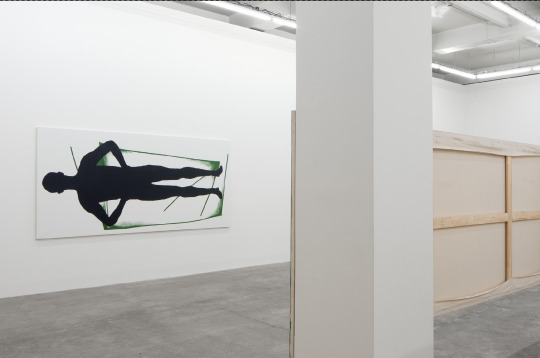
German artist Max Ruf always starts with a spark. Working with the immediacy of primary colors, he translates a horizon, a beam of light, or an architectural detail into an abstraction. The result is layers of shapes and lines that form a palimpsest, in which the original reference to nature or urban space is overwritten by other interpretations—that of the artist and the viewer. With each layer of paint, the original reference to the “real world” becomes indecipherable, much like a game of visual “telephone.”
Ruf also uses his painting practice to manipulate architectural space and perspective. In one instance, he turns a painting of a running horse upright, as if by defying gravity the animal could burst through the ceiling. Similarly, he paints what he calls a “male prototype” and then promptly turns it on its side, dethroning the figure and rendering it non-functional. In the same gallery, Ruf installed paintings across the columns holding up the space in order to divert and direct the movements of its visitors. In another gallery, Ruf broke the room in half entirely by installing another floor straight down the middle horizontally. He notes that many passersby mistook the work for a construction site, which was its intended effect: to play with the notion of urban space as fluid and ever-changing.
Ruf currently draws inspiration from New York City, where the skyline and street corners are always in flux, waiting to burst spontaneously into layers of colorful abstractions on his canvas.
#max ruf#residency#art residency#residency unlimited#german art#abstract#space#architecture#urban space#horizon#new york city#palipsest
0 notes
Text
Studio Visit: Lőrinc Borsos


Since 2008, Hungarian artists Lilla Lőrinc and János Borsos have worked under the joint name Lőrinc Borsos, fusing their identities to reflect a duality of gender, sexuality, age, and artistic practice. Alongside the notion of a singular identity, Lőrinc Borsos challenge ideas of religion, nationality, and iconography. For example, in Cute Little Aquarelles I and II, the artists paint watercolor postcards depicting modified Hungarian statues and other national symbols. In Immovable Land, they place a clay model of the Hungarian Parliament on a vibrating table that starts to move whenever a visitor approaches. The process is complete only when the last particle of dust falls from the table. The work reflects the artists’ engagement with Christianity and biblical myth—in this case, Hebrew 12:26, in which God promises to shake "not the earth only, but also heaven.”
In Flags, Lőrinc Borsos edit another national symbol: the flag. The work consists of three Hungarian flags in a row, where one of the tricolored stripes on each has been painted over with black paint. On June 27, 2017, their work See no evil, hear no evil, speak no evil was censored from an exhibition at the Hungary Institute before it opened. According to the artists, their objective was not to incite a political scandal but rather to offer a critical response to the title of the exhibition — Real Hungary. As Hungary moves further into the xenophobia of right-wing populism and extremism, Lőrinc Borsos explain that it has become increasingly difficult for them to operate as critical artists. “We have cried many tears,” says Lilla, “but ultimately we have to continue creating.” This push and pull between hope and despair is reflected in their choice to use Blaek, a glossy black enamel paint that contains opposing qualities within it, simultaneously absorbing and reflecting light.
#hungarian art#hungary#hungarian artist#residency unlimited#art residency#Lőrinc Borsos#flags#censorship#art duo#nationalism#religion#iconography#state
0 notes
Text
Studio Visit: Remijon Pronja
Albanian artist Remijon Pronja’s early work explores what it means to survive as an artist in precarious economic times. Il vuoto nello spazio² is a series of drawing he created during his time as a student in Milan. The collection includes sketches alongside hand-scrawled lists of numbers: rent, tuition fees, and calculations of household expenses are juxtaposed next to the hours of work needed to pay everything off. Similarly, in Fibonacci Receipt, Pronja prints a catalogue of receipts that reflects the cost of making the piece itself. Much like the Fibonacci sequence, the value of the book progresses with every page printed.
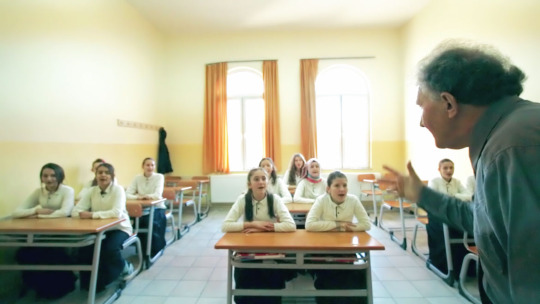
More recently, Pronja has turned towards exploring a different notion of precarity: that of European identity. Two video installation pieces— “Untitled in Allegro Moderato” (2015) and “An Die Freude (Nushid AlFarah – نشيد الفرح)” (2016)—revolve around Ludwig van Beethoven’s Ninth Symphony, based on Friedrich Schiller’s late 18th century poem “Ode to Joy.” In “An Die Freude,” female pupils in one of Albania’s Madrasa religious schools sing the “Ode” in Arabic. As protagonists of the piece, the pupils as creating something entirely new. The Arabic version of the song, while retaining a notion of European “tradition,” also uniquely reflects the position of Albania as one of Europe’s only constitutionally secular, Muslim-majority countries. In “Untitled in Allegro Moderato,” Pronja scrambles the notes of “Ode to Joy” by drawing a map of the EU on the sheet music using water, thus altering the musical score, and with it, the concept of a unified expression of European identity.
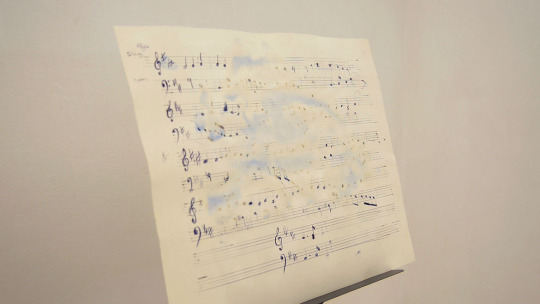
As theorist Slavoj Žižek argues, while the Ode is generally taken for granted as a grand symbol of humanity, brotherhood, and freedom for all, it contains a darker undertone within it. It has variously been adopted by the Nazis, the Soviet Union, the extreme right in apartheid South Rhodesia, and the extreme left of the violent Shining Path of Peru. Through his video work, Pronja seems to suggest that the idea of a united and homogenous Europe is as much as a myth as that of the “perverse scene of universal fraternity” claimed by the Ode to Joy, and a dangerous myth at that.
#ode to joy#ramijon pronja#residency unlimited#art residency#europe#european union#immigration#islam#arabic#beethoven#art#artist#albania#albanian art
0 notes
Text
Studio Visit: Oneika Russell

In A bit of what you fancy, Jamaican artist Oneika Russell asks her friends to strike a traditionally “Jamaican pose.” She then transforms their bodies —contorted, dramatic, often hyper-sexualized, sometimes humorous—into dark silhouettes, which are then projected onto a background of bright Caribbean foliage. The piece reflects Russell’s interest in how the Caribbean presents itself as a place for consumption, and even more so, how it is received as exotic and consumable by certain audiences. She explains that Caribbean identity is often a strange place to inhabit: “It is an experience which is tied to the idea of marketing our land, our bodies, and our culture.”
In Postcard Preservations, Russell explores the marketing of identities through the material and cultural dynamics of the tourist industry. The body of work takes postcards collected from her childhood and adolescence in Jamaica (1980s to early 2000s), which “sell” the Caribbean as a terra nullius of empty beaches and lush greenery, a fantasy that contains a certain colonial nostalgia within it. Russell alters these images through printed work, video and drawing. Through mixed media, she finds a hybridity that both extends and challenges such representations. “For example,” she says, “how does one make a print which looks like a painting or an advertisement, and how can it also feel like a book or a film? How can you make an image which is both beautiful and uncomfortable at the same time?”
#jamaican art#jamaica#caribbean art#caribbean#tourism#tourism art#oneika russell#residency unlimited#residency#artist residency#postcard art#postcards#terra nullius#animation#drawing#painting
0 notes
Text
Studio Visit: Jérôme Stünzi and Old Masters
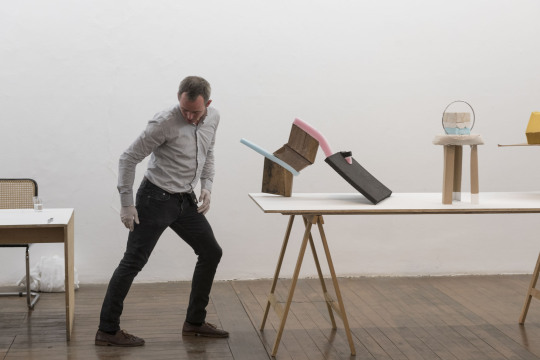
In Constructionisme, Swiss artist Jérôme Stünzi transforms discarded objects and trash found at Paris’ Centre Pompidou into minimalist kinetic sculptures which seem to possess a personality of their own. His colleague Marius Schaffter, a performer and geographer, then stages a public performance in the same museum, in which he presents, analyzes, and dissects the sculpture, imitating the droll demeanor of a museum docent. He anatomically describes the sculpture’s surface details, including its color and shape, before slowly sliding into an erratic and absurd stream of consciousness about politics, religion, and reality. The audience responds in turn — vague interest is followed by confusion and uncomfortable laughter as Schaffter begins to touch and dissect the sculpture in the middle of the museum.
As part of their art collective Old Masters, the duo has performed the piece in a number of galleries, museums, and academic conferences, using the intervention to question and reconstruct institutional culture and etiquette. The piece reminds me of Andrea Fraser’s 1989 Museum Highlights: A Gallery Talk, in which the artist becomes a fictional docent giving a tour of the Philadelphia Museum of Art while commenting on the building’s toilets, cloakroom and exit sign. Much like Stünzi and Schaffter’s Constructionisme, Fraser’s performance offers a sharp critique of the art world as well as the class interests and protocols which uphold certain power dynamics within it. As the Old Masters write: Bonjour l'iconoclasme!
#institutionalism#art institution#critique#performance#sculpture#found objects#trash#andrea fraser#jerome stunzi#swiss artist#residency unlimited#art residency#art#artist#performance art#museum#museum critique
0 notes
Text
Studio Visit: Neža Knez

Slovenian artist Neža Knez explores the intersection of body, space, and senses. In 2014, she collaborated with a group of blind people in the city of Ljubljana to translate textual graffiti into braille. “Blind people are only given instructional information when they need it,” she explains. “We never think about all the other visual information we consume,” including messages which span from the political and inspirational to the vulgar and mundane. A year later, Knez blindfolded herself and lived in a state of blindness for ten days. During that time, she kept a detailed journal and noted how her interactions with space had shifted. During her commute, for example, her hands found a fire extinguisher on the wall of a hallway she had walked down countless times before, a previously inconspicuous object that became a crucial guiding point for her while she lived in darkness. As part of the project, she made three sculptural portraits—the first by memory, the second by touching the face of a model, and the third using only verbal descriptions of the model. When she asked blind colleagues to touch these portraits, they noted how realistic they felt.
Knez’s other works engage auditory communication, as in her voice portraits of people slowly pronouncing the Slovene alphabet, or in her performative readings of Italian texts—a language that she does not speak—in a public library in Milan. By reading the foreign text aloud, Knez explains that her mispronunciations transform language into mere audio, what she calls “pure voice.”
#blindness#blind#senses#auditory#art#artist#artist residency#slovakia#neza knez#braille#blindfold#sculpture#portraits#language#italian#ljubljana#residency unlimited
1 note
·
View note
Link
1K notes
·
View notes
Text
Studio Visit: Osvaldo González Aguiar

Havana’s Morro Castle has witnessed a history of colonial conquest and revolution. Originally under the control of the Spanish, the fortress was captured by the British in 1762. It served as a military prison during the dictatorships of the early twentieth century, and after Fidel Castrol’s victorious troops entered Havana on January 8, 1959, Che Guevara used the space to oversee the executions of individuals deemed to be enemies of the revolution. In 2012, as part of the Havana Biennial, Cuban artist Osvaldo González Aguiar shifted the narrative of violence surrounding the Morro Castle by constructing Una Escena Doméstica, a quiet domestic scene in the fort’s interior. The electric light that shines through the scotch tape surrounding a fireplace, chair and bouquet of dried flowers gives off an amber glow.
For Aguiar, amber contains healing powers. Many of his site-specific installations are wrapped in the color. “It is said that amber is the stone that contains the sun,” says Aguiar, “and this is the link that I establish by wrapping the space and creating an effect of amber-colored light. It’s taking a simple, trivial act, into a poetic idea.”
2 notes
·
View notes
Text
Studio Visit: Maess Anand

In her series Abnormal Results, Polish artist Maess Anand draws upon cancer databases, microscopic views, histopathology images, Kaplan-Meier curves, 2D visualization software and 3D modeling software to create an image of cancer that straddles the boundary between science and art. The result is an explosive splatter of cells and tissue intersected by the occasional red lines of IV tubes pumping Adriamycin, the chemotherapy drug known as the Red Devil. Some of the drawings also contain data visualizations of tweets and retweets from those experiencing the disease, bringing to life what Paul Rabinow calls a “biosocial space,” a social community created by shared illness. Through tracing the connectivity and communications of those with breast cancer, Anand considers the ways in which cancer, while experienced in an individual body, can be thought of as a digital media event.
Yet she is careful to emphasize that neither the social web, nor the sprawling visualizations of cancer tissue, are meant to be seen as metaphors. In her 1978 book Illness as Metaphor, Susan Sontag similarly rejected the use of metaphors to explain cancer as a disease that afflicts people who repress their passion —“cancer personality,” as it was known in pop science at the time. Anand argues that in today’s popular analogies, breast cancer is often glamorized with pink ribbons, while lung cancer is seen as ugly, its causes blamed entirely on the victim.
While rejecting such pop mythology, Anand is not blind to the socio-political dimensions of biology. In one of her pieces, she sketches the cancer cells known as HeLa, taken from African American tobacco farmer Henrietta Lacks in 1951 without her knowledge or consent. In her current work, Anand engages the art of Polish sculptor and Holocaust survivor Alina Szapocznikow, who was diagnosed with breast cancer in 1968. While Szapocznikow’s sculptures visualize only what was visible on the surface of her body, Anand is able to use digital tools to see cancer on a cellular level, exploring the mysterious, interior depths of what makes us human.
#artist#artist residency#cancer#biology#biology art#science#science art#scientific art#susan sontag#illness as metaphor#alina szapocznikow#henrietta lacks#cancer cells#body#anatomy#breast cancer#lung cancer#maess anand
0 notes
